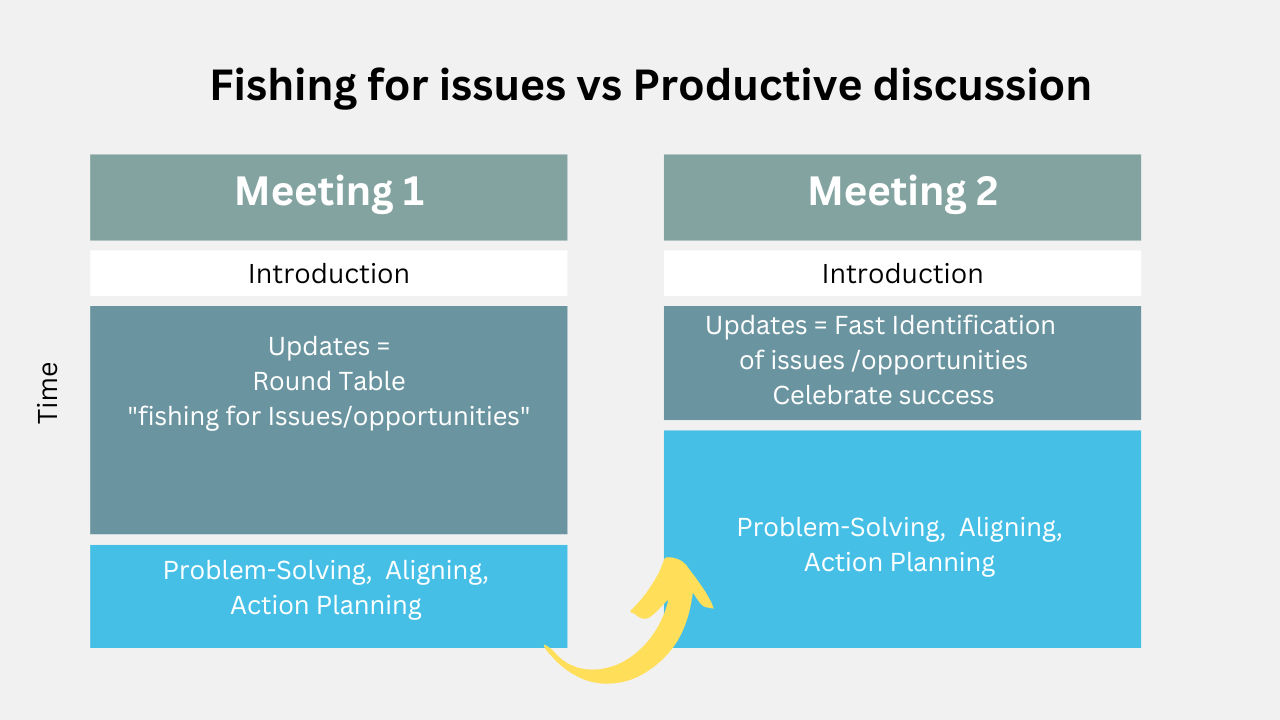No one has enough time, and everyone seems stuck in too many meetings.
Imagine the scene, as I know we’ve all been there.
You are busy. A massive to-do list awaits, and you are sitting in a meeting. The meeting leader then says the ominous, “Shall we go around the table and update what has happened since last time?”
Here we go, 20 minutes of round-the-table randomness, whilst each person shares their update. Here we will find quality insights and off-topic observations, some successes and some issues, but mainly, it becomes noise.
If it’s a virtual meeting, you can guarantee people are doing their email whilst other people share their updates, half-listening and waiting their turn.
For the meeting leader the random comments are difficult to pull together and often create more random discussion, some action and then the time is up, and everyone leaves.
If this is familiar to you, here are 3 actions you can take to avoid Meeting Update Hell and shine as a meeting leader.
First, it's important to know why we, as managers and meeting leaders, do updates. It’s normally for the following reasons.
- We want to know what's going well and what is not. We want to know if we are on track and what issues we are going to have to address to achieve the goal. But this information is often lost in the noise. When a meeting update goes off track, it’s like fishing for the issues and opportunities; we might catch them, but it is not guaranteed.
- We are encouraging accountability among the meeting participants. Instead, what we often get is a show. No one wants to say, ‘This is difficult, and I’m not sure we are going to get this done’, especially in front of their colleagues, so there is a tendency to share good news and gloss over the bad.
- Knowledge sharing. We genuinely want the information shared to keep everyone informed, but we have picked an inefficient way of doing it.

To keep meetings short, focused, and action-oriented, you need to invert the time spent updating for the time spent problem-solving. This will focus everyone on the high-value outputs of the meeting and prevent random updates.

1. Prepare well and design the conversation
- Schedule time to prepare for the meetings you lead. If you prepare on the fly, the meeting will lack focus and thought.
- Get clear on the purpose and what the outputs will be. Once you have done this, it is much easier to design the best way to have the conversation within the meeting.
For example: By the end of this meeting, we will understand what has gone well so far, what are the key issues we face, and what we can do about them to ensure we achieve this goal.
- Design the conversation using questions to focus the discussion. You can put these on the agenda to help people prepare.
For example:
What has gone well so far? What do we have to celebrate?
What are the key issues we face?
What do you think are the most important issues for us as a team?
What options do we face to address this issue?
What do you think would be the most successful course of action?
2. Update and share the issues before the meeting to get ahead
- Use asynchronous ways of updating each other before the meeting. You could start the session having grouped them and finding out what the team thinks is the most important.
- You can use shared docs or spreadsheets, polls or forms, or a team discussion channel in MS Teams or Slack to help you. Avoid email (everyone has too many already!) and use more transparent topic-related collaboration methods to aid information sharing.
3. Focus your questions to guide the discussion
- Use the questions you have already planned to guide your facilitation and keep everyone focused on the answers.
- Keep your questions open-ended (how, what, where, when) to find out information and closed questions (do you, is it?) to clarify and confirm understanding as these get the answer yes or no.
- Use flip charts or digital whiteboards to keep up to date with what is being said.
- At the end of the meeting, confirm the actions and check they achieved the purpose of the meeting and that everyone is aligned.
If you recognise these symptoms in the meeting you run, you need to take action to try something new. Remember, the people who create meetings with the best productive debate and action tend to have the most influence and impact.
Action Step: Look ahead at an upcoming meeting you are planning and schedule some time to prepare in order to invert time between updating and problem-solving. Try one or two of these tactics to see how it could impact the quality of your meetings.




